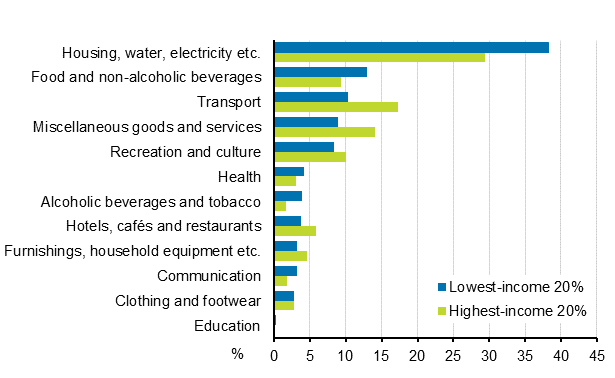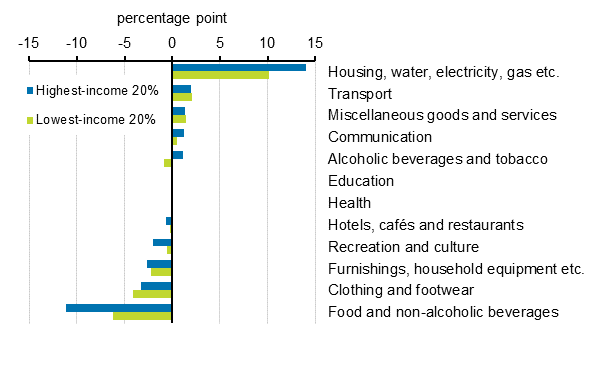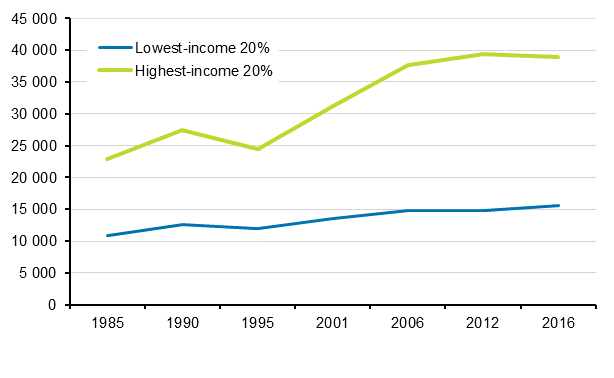Published: 13 March 2018
Over one-half of the expenses of lowest income earners are spent on housing and food
For the lowest-income quintile, the housing expenditure, such as rent, heating and water charges, alone claim 40 per cent of the household’s consumption expenditure. Good one-tenth is spent on food. The share of housing expenditure in the consumption expenditure of low income earners has grown strongly in 30 years, by 14 percentage points. At the same time, the share of food expenditure has fallen. Food is still the second biggest expenditure item of low income earners.
Shares of consumption expenditure by main group according to the houshold’s income group in 2016 (per cent of consumtion expenditure)

The highest-income quintile spends 39 per cent of their expenditure on housing and food. Housing is also the biggest expenditure item for high income earners, but food comes only fifth after transport and leisure expenses, for example. High income earners spend 17 per cent of their expenditure on transport, low income earners 10 per cent. Transport expenditure includes such as acquisitions and maintenance of transport equipment, fuels, use of public transport and independent trips in Finland and abroad. The share of transport expenditure has grown in both income groups by a few percentage points over 30 years.
Changes in consumption expenditure by main group according to the household’s income group from 1985 to 2016 (percentage points)

Although changes in the shares of housing expenditure and food expenditure are considerably bigger for low income earners, the consumption structure of households as a whole has developed similarly regardless of the income group. The only consumption group where the development appears to be opposite is consumption of alcohol and tobacco. High income earners spend a slightly smaller share of their expenditure on intoxicants and low income earners a bigger share than 30 years ago.
The structural change of households has accelerated the growth in private consumption. Small one-person and two-person households have become general rapidly. In 1985, they accounted for 55 per cent of households, now their share is 75 per cent. Because a small household needs certain commodities as much as a bigger one (e.g. household appliances, data connections), the growing number of households leads to an increase in the consumption of these commodities.
When we want to find out how Finns’ consumption has developed in numbers (in real terms) in different income groups, the effect of both households’ structural change and price changes have to be removed from the time series figures. This takes place by dividing households’ consumption expenditure in different years by the change coefficients for the value of money and by calculating the expenditure per so-called consumption unit 1) . The consumption unit in practice means that the consumption expenditure of different types of households is converted to correspond to the consumption of an adult living alone. Thus, the consumption of households of different size and age can be compared with one another.
Real development of consumption expenditure by income group in 1985 to 2016 (in 2016 money, EUR per consumption unit)

The differences between the highest and lowest income quantiles in consumption expenditure have grown in the course of 30 years. During ten years after the recession of the 1990s, the highest-income quintile increased its consumption in real terms by 54 per cent, while at the same time, the consumption of lowest income earners grew by 24 per cent. During the latest downturn, the growth in consumption differences halted and narrowed down somewhat. The consumption expenditure of the highest income quintile is now around two and a half-fold compared with lowest income earners.
A total of 3,673 households were interviewed for the Household Budget Survey in the course of 2016. The comparable time series of consumption now extends to over 30 years covering the years 1985 to 2016. The database tables of the time series are available free of charge.
1) The consumption units are based on the so-called OECD's modified scale. One adult in the household is one consumption unit. Other persons in the household aged at least 14 are 0.5 consumption units each and children aged 0 to 13 are 0.3 consumption units each. A household with one adult member is one consumption unit, while a household consisting of spouses and one child aged under 14 together are 1.8 consumption units. Consumption calculated by means of consumption units takes into account the size differences between households and enables their comparison with one another.
Source: Households' consumption 2016, Statistics Finland
Inquiries: Mira Kajantie 029 551 3626, Tuomas Parikka 029 551 3276
Director in charge: Jari Tarkoma
Publication in pdf-format (190.9 kB)
- Tables
-
Tables in databases
Pick the data you need into tables, view the data as graphs, or download the data for your use.
Updated 13.3.2018
Official Statistics of Finland (OSF):
Households' consumption [e-publication].
ISSN=2323-3028. 2016. Helsinki: Statistics Finland [referred: 19.4.2025].
Access method: http://stat.fi/til/ktutk/2016/ktutk_2016_2018-03-13_tie_001_en.html

